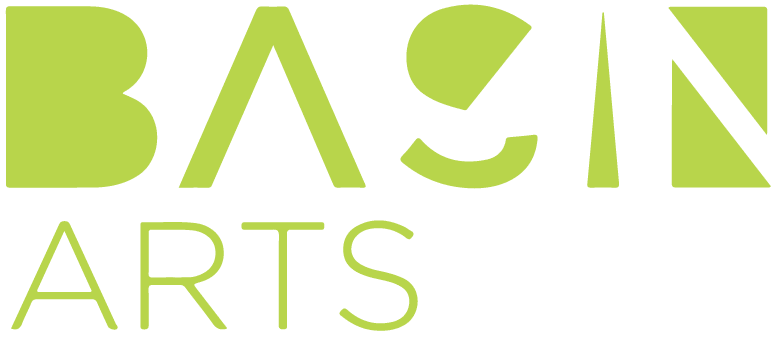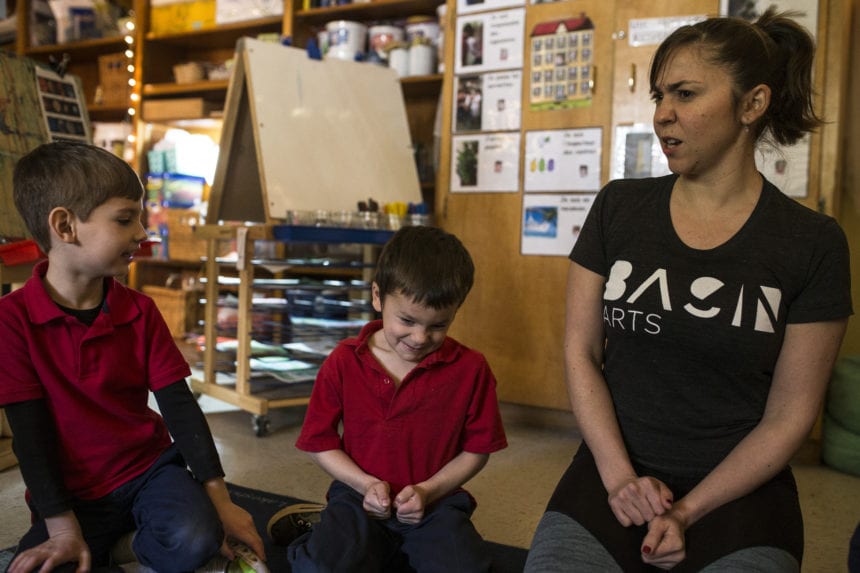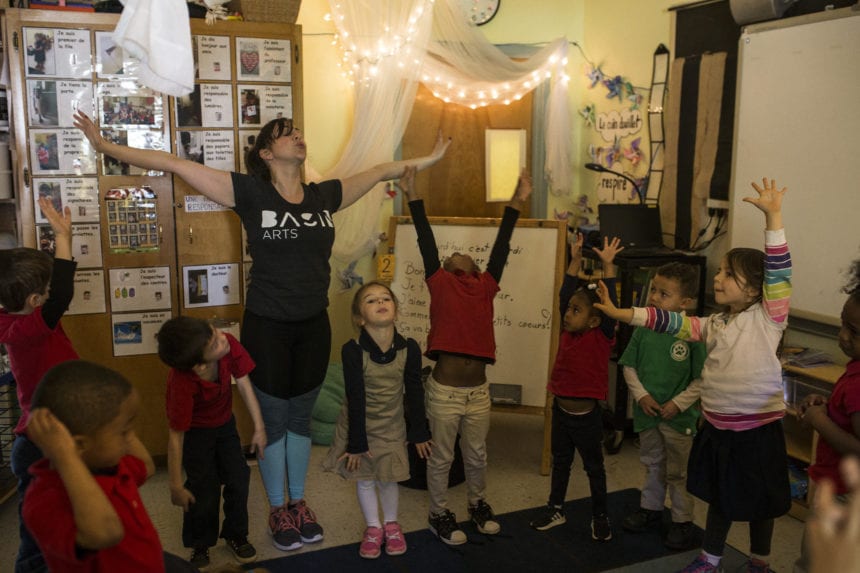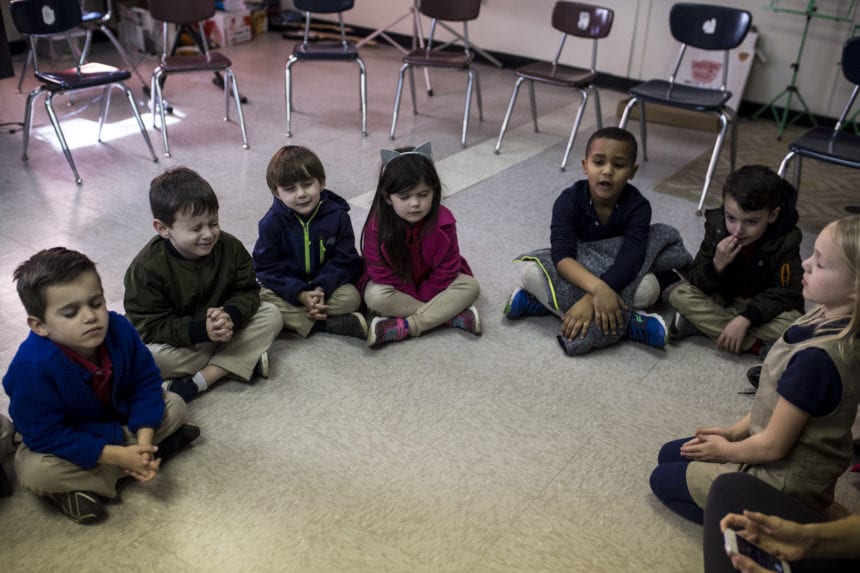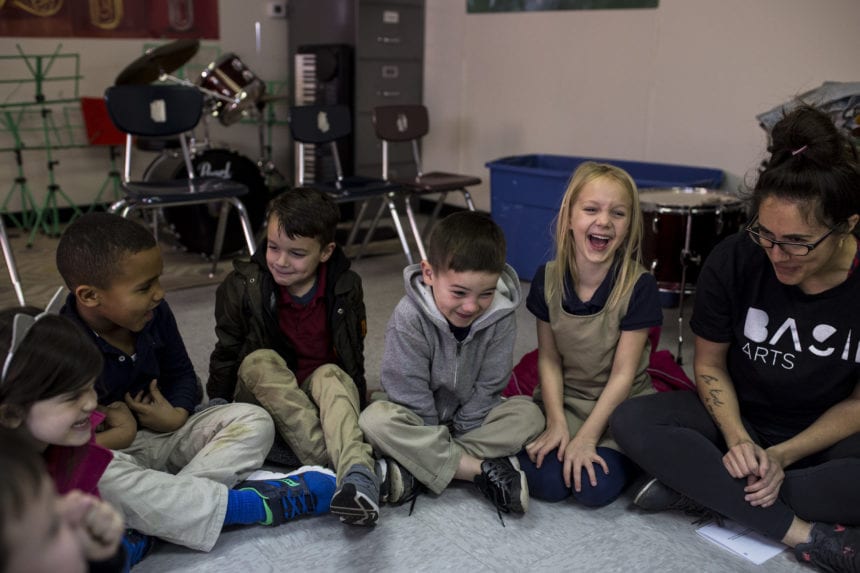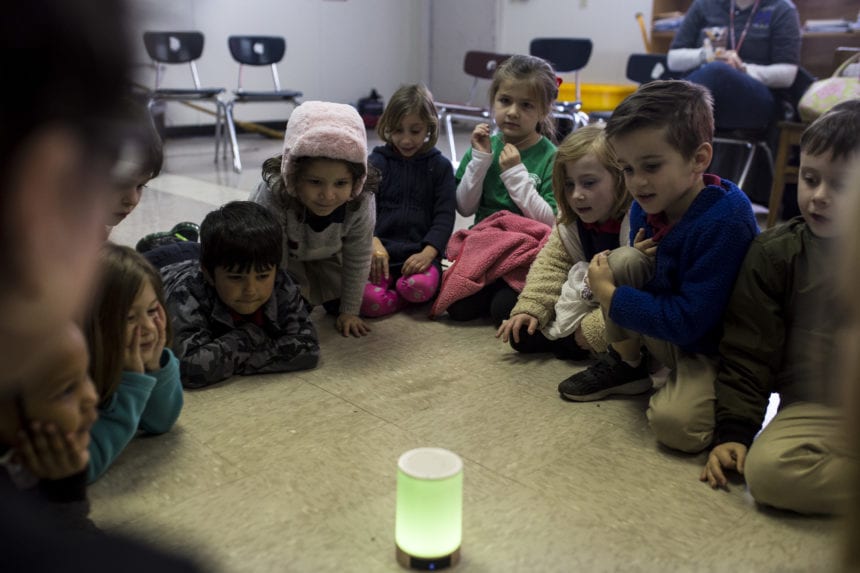Mindfulness & Movement at Myrtle Place Elementary
Elementary Embodiment
The idea of bringing Mindfulness into classrooms has been gaining recent popularity across the country and in Lafayette, it’s no exception. Last year Madame Catherine Bricelj, principal of Myrtle Place Elementary School, contacted Basin Arts to ask us to put together a Mindfulness Program. This would include developing and implementing a regularing occurring program curriculum for grades Pre-K through 5. What an opportunity! We of course said “Yes!” Planning began amidst much reading and research last summer, and in the fall we were given the opportunity to present our intentions to the teachers as well as parents.
We enthusiastically started teaching the students at the end of August 2018, our program began simply: What is Mindfulness? We define Mindfulness as Awareness, but not just cognitive awareness. Mindfulness is Full-Body Awareness. We began our first class–as we’ve begun all of our classes since–with sound and with our breath. By using our whole bodies, we learn to focus our attention more fully. Sitting up tall in what we call Our Mindful Bodies–hands in our laps, mouths closed, eyes closed, ears open–we tune in to the sound of a bell. Our goal and practice is to remain quiet for the entire duration of its chime. We begin and end each session this way. We then bring our awareness to our breath and attach our breath to movement with what we call our Rainbow Breathing. As we inhale, we lift our arms up overhead, and as we exhale we paint our fingers down an imaginary arc creating the shapes of rainbows. This attention to breath is carried throughout many parts of our sessions as a way to focus our minds and to calm ourselves. And breath doesn’t have to be boring. We sometimes sip our breath as though it’s through a straw and we might breathe out like a waterfall, or a snake, or a lion, pairing sound and control with our breath.
Each session is designed around a specific goal we’ve set to develop. This development occurs through the use of a myriad of tools and creative play. Through Self-Reflection, we asked students to examine questions such as What makes us happy? Sad? Angry? Scared? Grateful? Proud? Excited? Peaceful? Becoming aware of what makes us feel certain ways helps us to learn about ourselves and our own personal preferences. Learning these same things about each other teaches us that we’re different and that all of these differences are valid. Knowing this, we can learn to respect others’ preferences and ask them to respect ours as well. We explored Embodiment; through movement, stillness, and reflection we can learn how different emotions are sensed and experienced in our bodies. Anger might make us feel hot. Fear might make us feel cold or shaky. Happiness might also make us feel shaky with excitement and energy. Sadness might make us feel heavy and tired. These are reflections directly from the students. Given the time and space to be in their bodies and to be asked questions about their experience gives them the opportunities to make these connections and have these concepts occur to them through self-revelation.
Students learned how to focus their attention through the use of their senses; how strong and agile their bodies are; how to cooperate; how to use the breath as a tool for focusing, calming, and centering; that there are certain expectations in different environments and that they have the tools to meet those expectations. Through the use of sound, they focus their attention whether it’s with the use of the bell or with the use of music and silence to indicate when to move and when to find stillness. With the use of space, they learn to move within their own bodies and around one another in spaces sometimes defined by physical boundaries and sometimes by imaginary ones. They learn how to take up space and how to share it. By using the sense of sight and color, they learn to focus their attention on a specific object or focal point to avoid distraction. By exploring their own emotions, recognition of emotions in others, and the concept of empathy they become better able to identify how they feel, all reminders which help them to articulate those feelings and ask for what they need instead of acting out. Awareness of how emotions feel in our bodies and how our bodies look when we feel certain emotions is what helps us to identify when others are feeling that way too. An observant eye helps us to comfort others or give them space.
We’ve covered Cultivating and Sharing Happiness, identifying what happiness feels like in our bodies and sharing it with others. Students learned to Trust themselves and each other through games where they sometimes had to focus and balance or other times had to close their eyes and trust a classmate to guide them–the students especially enjoyed being led by each other through a simple imagined obstacle course over a river and through a wall of fire. We spent time Cultivating Gratitude, brainstorming together and sharing out loud about things we’re thankful for, ways people have been kind to us, what makes us proud of ourselves, and then students wrote thank you notes to others and also to themselves. Students also learned the value of Working Hard and Challenging Themselves through physical effort, balance, focus, teamwork, and both personal and group efforts, leaving the session with an affirmation of “I can do it!” Other sessions involved pairing affirmations with balancing postures, movement, and facial expressions–“When I fall, I’ll find balance again;” “When I’m upset, I’ll be calm again;” and “When I’m sad, I’ll find happiness again”–reminding us that difficult experiences are temporary states of being. We examined concepts of Organization and Chaos: where do we find organization? why is it helpful? how can we organize our bodies and how can we make them chaotic? and how does that make us feel? We also developed Kindness through Intention, directing our kindness first to ourselves saying, “May I be healthy and strong. May I be happy and peaceful” and then directing that kind intention outward to our classmates, our school community, and our whole world. Games were created to safely experience Rules and Boundaries, and Creating Space Between Our Emotions and Our Responses. Through all of this play, reflection, talking, and listening we offered tools to help students Find and Maintain their Center (their sense of calm and self-control) amidst chaos and distraction, tools to develop a Mindful Awareness and the ability to carry that toolkit within them wherever they go.
As we are wrapping up our mindfulness practice for this school year we are truly humbled to learn the students seem to be utilizing their toolkit. Madame Bricelj filled us in on the number of disciplinary referrals for this year versus the disciplinary referrals at this same time last year, and that number is nearly 55% lower! We’ve also had the opportunity to hear stories and feedback from some parents who have seen positive behavioral and emotional shifts in their children at home. This is what Mindfulness is all about, learning to regulate ourselves to create more peace within and thus become an active contributor to a more harmonious environment.
Blog Post by: Ana Leger
